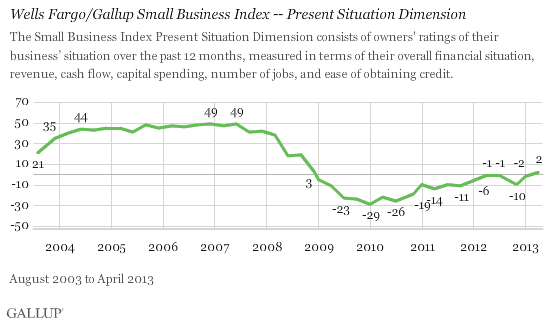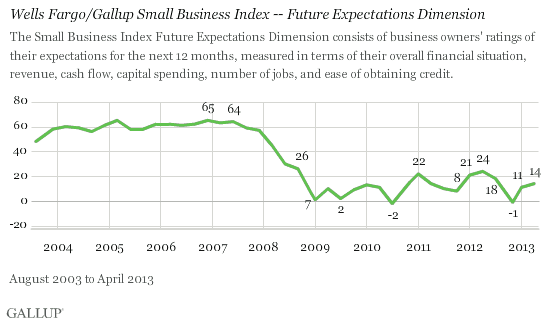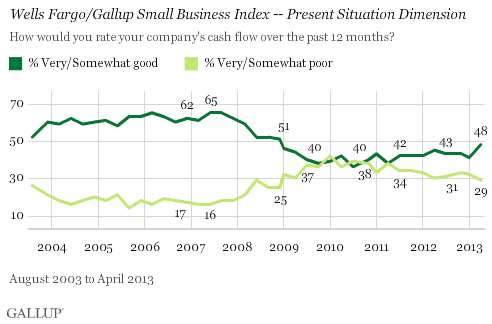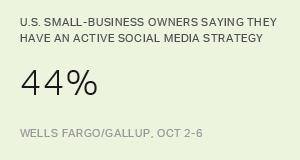PRINCETON, NJ -- U.S. small-business owners became slightly more optimistic in April, with the Wells Fargo/Gallup Small Business Index rising to +16, from +9 in January. Owner optimism had plunged to -11 after last year's presidential election. Although improved, the index is still below the +23 found in April 2012.

Prior to the recession and financial crisis of 2008-2009, index scores were generally in the triple digits. The Wells Fargo/Gallup Small Business Index was initiated in August 2003, reached its peak at 114 in December 2006, and hit its low point of -28 in July 2010.
Slight Improvements Seen in Present and Future Dimensions
Small-business owners' ratings of their current operating environment improved modestly in April, with the Present Situation Dimension of the index increasing to +2 from -2 in January and -10 in November. This is the first time the Present Situation Dimension has been in positive -- if still broadly neutral -- territory since December 2008.

The Future Expectations Dimension of the index, which measures owners' expectations for their businesses' operating environment over the next 12 months, increased to +14 in April from +11 in January and -1 in November. Small-business owners were modestly more optimistic about their future operating environment a year ago, when this dimension stood at +24.

Stronger Cash Flows Boost Owner Optimism
Small-business owners report significantly improved cash flows; the 48% rating their companies' cash flows over the past 12 months as very or somewhat good is up from 41% in January. This is the most positive owners have been about their cash flow situation since December 2008, when 51% rated their companies' cash flows as very or somewhat good.
Separately, 53% of owners expect their companies' cash flows to be very or somewhat good over the next 12 months.

Implications
An improved cash flow situation made many small-business owners feel a little more positive in general in April. This is a turnaround from just after last year's presidential election, when owners generally turned pessimistic. By January, owners' perceptions had changed and they had become slightly optimistic.
During recent weeks, Gallup data have shown Americans' economic confidence steady at a slightly improved level. Gallup's Payroll to Population measure also shows the job market improving modestly -- in line with the government's unemployment report for April. These are positive factors for the small-business operating environment and, combined with the U.S. stock market hitting new highs, they suggest that small-business-owner optimism may have increased even further since the survey was conducted in early April.
Still, Gallup's measurement of consumer spending shows spending continues to lag behind pre-financial crash levels. It may be that small-business-owner optimism will not increase significantly until consumer spending -- and the related small-business revenues -- shows real improvement. Gallup will continue monitoring consumer spending in the weeks ahead to see if early May optimism creates increased consumer spending -- and increased small-business optimism.
About the Wells-Fargo Small Business Index
Since August 2003, the Wells Fargo/Gallup Small Business Index has surveyed small-business owners on current and future perceptions of their business financial situations.
Survey Methods
Results for the total dataset are based on telephone interviews with 603 small business owners, conducted April 1-5, 2013. For results based on the total sample of small business owners, one can say with 95% confidence that the maximum margin of sampling error is ±4 percentage points.
Sampling is done on a random-digit-dial basis using Dun & Bradstreet sampling of small businesses having $20 million or less of sales or revenues. The data are weighted to be representative of U.S. small businesses within this size range nationwide.
In addition to sampling error, question wording and practical difficulties in conducting surveys can introduce error or bias into the findings of public opinion polls.
For more details on Gallup's polling methodology, visit www.gallup.com.
